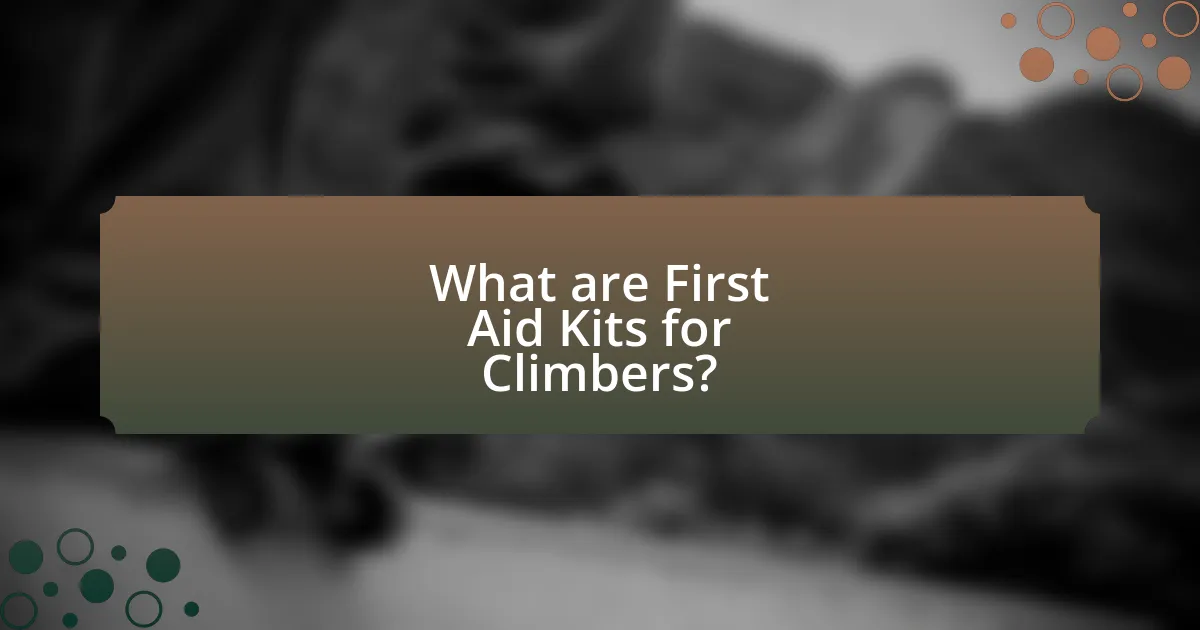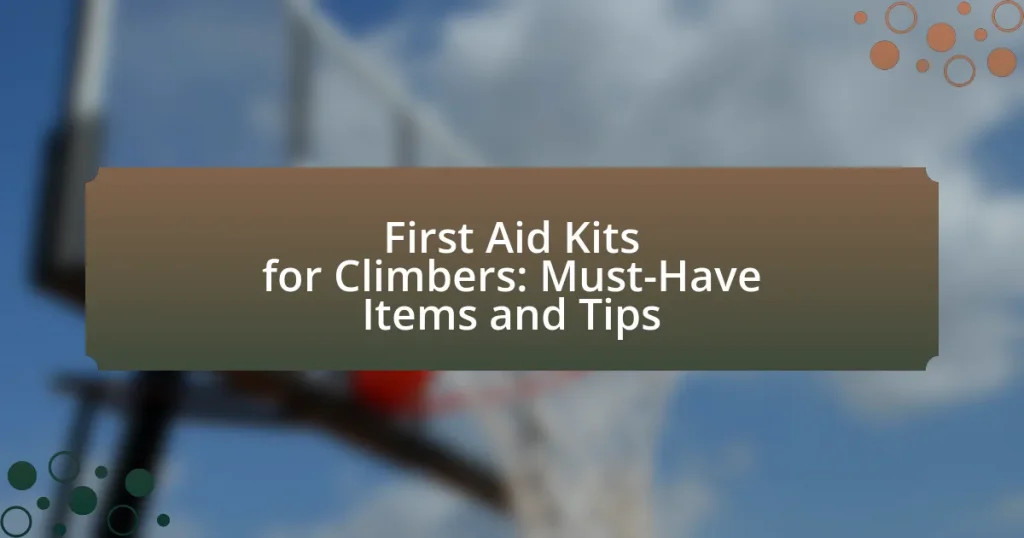First Aid Kits for Climbers are essential medical supplies tailored to address injuries and emergencies encountered during climbing activities. These kits typically contain items such as adhesive bandages, antiseptic wipes, gauze pads, and splints, specifically designed to treat common climbing-related injuries like cuts, sprains, and fractures. The article outlines the importance of having a well-equipped first aid kit, the types of injuries climbers may face, and best practices for customizing and maintaining these kits. Additionally, it emphasizes the need for climbers to stay informed about first aid techniques and to regularly assess their kits to ensure preparedness for emergencies in various climbing environments.

What are First Aid Kits for Climbers?
First Aid Kits for Climbers are specialized medical kits designed to address injuries and emergencies that may occur during climbing activities. These kits typically include essential items such as adhesive bandages, antiseptic wipes, gauze pads, and splints, tailored to treat common climbing-related injuries like cuts, scrapes, and sprains. The inclusion of specific items, such as a triangular bandage for slings or a cold pack for swelling, enhances their effectiveness in outdoor environments. The American Red Cross recommends that climbers carry a first aid kit that meets their specific needs based on the duration and location of their climbs, ensuring preparedness for potential accidents.
Why are First Aid Kits essential for climbers?
First Aid Kits are essential for climbers because they provide immediate medical assistance in case of injuries or emergencies that can occur during climbing activities. Climbing often involves risks such as falls, cuts, sprains, and altitude sickness, making it crucial to have the necessary supplies to address these issues promptly. For instance, a study by the Journal of Wilderness and Environmental Medicine highlights that injuries are common in climbing, with a significant percentage requiring first aid treatment. Having a well-stocked First Aid Kit enables climbers to manage injuries effectively, potentially preventing complications and ensuring safety during their adventures.
What types of injuries can occur while climbing?
Climbing can lead to various types of injuries, including sprains, fractures, cuts, and abrasions. Sprains often occur due to falls or improper foot placement, while fractures can result from falls or impacts with rocks. Cuts and abrasions frequently happen from contact with rough surfaces or equipment. According to a study published in the Journal of Sports Medicine, approximately 30% of climbing injuries involve the upper extremities, highlighting the prevalence of hand and wrist injuries.
How can a well-equipped first aid kit mitigate climbing risks?
A well-equipped first aid kit can mitigate climbing risks by providing essential medical supplies to address injuries and emergencies that may occur during climbing activities. This kit typically includes items such as adhesive bandages, antiseptic wipes, gauze, and splints, which can be crucial for treating cuts, scrapes, and fractures that climbers may sustain. For instance, research indicates that injuries in climbing often involve falls, leading to abrasions or sprains; having the right supplies allows for immediate care, reducing the risk of infection and promoting faster recovery. Additionally, a first aid kit can include emergency items like a whistle or a mirror for signaling help, which enhances safety in remote climbing locations. Thus, the presence of a comprehensive first aid kit directly contributes to the ability to manage climbing-related injuries effectively, thereby reducing overall climbing risks.
What are the key components of a climber’s first aid kit?
A climber’s first aid kit should include adhesive bandages, antiseptic wipes, gauze pads, adhesive tape, scissors, tweezers, pain relievers, a triangular bandage, and a first aid manual. These components are essential for treating common injuries such as cuts, scrapes, and sprains that may occur during climbing activities. The inclusion of antiseptic wipes helps prevent infection, while gauze pads and adhesive tape are crucial for dressing wounds. Pain relievers provide immediate relief from discomfort, and a first aid manual offers guidance on how to handle various medical situations.
What basic supplies should every climber include?
Every climber should include a first aid kit, a multi-tool, climbing gear, hydration supplies, and food. A first aid kit is essential for treating injuries, while a multi-tool provides various functions for repairs and adjustments. Climbing gear, such as harnesses and ropes, ensures safety during ascents. Hydration supplies, like water bottles or hydration packs, are crucial for maintaining energy levels, and food provides necessary sustenance during climbs. These items are fundamental for safety and well-being in climbing activities.
How do specialized items enhance a climber’s first aid preparedness?
Specialized items enhance a climber’s first aid preparedness by providing targeted solutions for injuries commonly encountered in climbing environments. For instance, items such as splints, which stabilize fractures, and high-altitude medications, which address altitude sickness, are specifically designed to meet the unique challenges climbers face. Additionally, specialized bandages for abrasions and lacerations can effectively manage wounds that occur from falls or scrapes against rocky surfaces. The inclusion of these items in a first aid kit ensures that climbers are equipped to handle emergencies efficiently, thereby increasing their safety and response effectiveness in remote locations.
How can climbers customize their first aid kits?
Climbers can customize their first aid kits by assessing their specific needs based on the type of climbing, location, and potential injuries. For instance, a climber in a remote area may prioritize items like splints and additional bandages, while those in more accessible locations might focus on basic supplies like antiseptics and pain relievers. Additionally, climbers should consider personal medical conditions, such as allergies or chronic illnesses, and include necessary medications or treatments. Research indicates that tailored first aid kits can significantly improve response times and outcomes in emergencies, highlighting the importance of customization for individual circumstances.
What factors should climbers consider when selecting items?
Climbers should consider the specific medical needs, the environment, and the weight of items when selecting first aid kit components. The medical needs include common injuries and ailments associated with climbing, such as cuts, sprains, and altitude sickness, which necessitate including items like adhesive bandages, splints, and altitude medication. The environment influences the selection based on factors like temperature and terrain; for instance, cold weather may require thermal blankets and specific medications for frostbite. Additionally, the weight of items is crucial since climbers need to minimize pack weight for efficiency and safety, leading to the choice of compact, multi-use items. These considerations ensure that climbers are adequately prepared for emergencies while maintaining mobility and efficiency during their climbs.
How does the climbing environment influence kit contents?
The climbing environment significantly influences kit contents by dictating the specific risks and challenges climbers may face. For instance, high-altitude environments require items to treat altitude sickness, while cold climates necessitate gear for frostbite and hypothermia. Additionally, rocky terrains may increase the likelihood of cuts and abrasions, prompting the inclusion of more bandages and antiseptics. Research indicates that environmental factors such as temperature, altitude, and terrain type directly correlate with the types of injuries sustained, thus shaping the essential components of a climber’s first aid kit.
What are the best practices for using a first aid kit in climbing?
The best practices for using a first aid kit in climbing include ensuring the kit is well-stocked with essential items, familiarizing oneself with its contents, and regularly checking for expiration dates on supplies. A well-stocked kit should contain items such as adhesive bandages, antiseptic wipes, gauze pads, and a splint, which are crucial for treating common climbing injuries like cuts, scrapes, and sprains. Familiarity with the kit allows climbers to quickly access necessary items during emergencies, reducing response time. Regular checks for expired supplies ensure that the kit remains effective, as outdated medications or materials may not provide the needed care. These practices enhance safety and preparedness while climbing.
How should climbers assess injuries before treatment?
Climbers should assess injuries before treatment by performing a systematic evaluation of the injured area, checking for signs of swelling, deformity, and range of motion. This assessment involves observing the injury, asking the climber about their symptoms, and determining the mechanism of injury to identify potential severity. For instance, a study published in the Journal of Wilderness Medicine emphasizes the importance of a thorough assessment to prevent complications and ensure appropriate treatment.
What steps should be taken for common climbing injuries?
For common climbing injuries, immediate steps include assessing the injury, applying R.I.C.E. (Rest, Ice, Compression, Elevation), and seeking medical attention if necessary. Assessing the injury helps determine its severity, while R.I.C.E. is a widely recommended method for managing sprains and strains, as it reduces swelling and promotes healing. According to the American Academy of Orthopaedic Surgeons, applying ice for 15-20 minutes every hour can significantly alleviate pain and swelling. If the injury involves fractures or severe pain, professional medical evaluation is crucial to prevent further complications.
How can climbers ensure their first aid kits are effective?
Climbers can ensure their first aid kits are effective by regularly reviewing and updating the contents based on specific climbing environments and potential injuries. This includes including essential items such as adhesive bandages, antiseptic wipes, gauze, and splints, which are crucial for treating common climbing injuries like cuts, scrapes, and fractures. Additionally, climbers should familiarize themselves with the use of each item in the kit through training or first aid courses, as proper knowledge enhances the effectiveness of the kit during emergencies. Regularly checking expiration dates on medications and supplies ensures that all items are usable when needed, reinforcing the kit’s reliability in critical situations.
What regular maintenance is required for first aid kits?
Regular maintenance for first aid kits includes checking expiration dates, restocking used items, and inspecting for damage. First aid supplies, such as bandages and antiseptics, have specific shelf lives, typically ranging from one to five years, depending on the item. Regularly reviewing and replacing expired items ensures the kit remains effective in emergencies. Additionally, after each use, it is essential to restock any items that were utilized to maintain readiness. Inspecting the kit for any signs of wear or damage, such as broken seals or compromised packaging, is also crucial to ensure that all components are safe and functional.
How can climbers stay updated on first aid techniques?
Climbers can stay updated on first aid techniques by participating in regular first aid training courses and workshops. These courses, often offered by organizations such as the American Red Cross or Wilderness Medical Society, provide current information on first aid practices and emergency response tailored for outdoor activities. Additionally, climbers can subscribe to relevant publications, follow reputable outdoor safety websites, and engage with climbing communities on social media platforms to access the latest updates and resources. This approach ensures that climbers are informed about new techniques and best practices in first aid, enhancing their preparedness for emergencies while climbing.
What tips can enhance first aid preparedness for climbers?
To enhance first aid preparedness for climbers, it is essential to regularly train in first aid techniques and carry a well-stocked first aid kit tailored for climbing scenarios. Regular training ensures climbers are familiar with emergency procedures, which can significantly improve response times during incidents. A well-stocked kit should include items such as adhesive bandages, antiseptic wipes, gauze pads, a splint, and a tourniquet, as these are critical for treating common injuries encountered in climbing, such as cuts, scrapes, and fractures. According to the American Red Cross, having a comprehensive first aid kit and knowledge of its contents can increase the likelihood of effectively managing injuries in remote locations.
